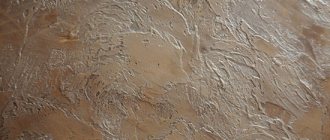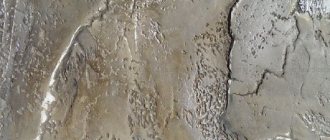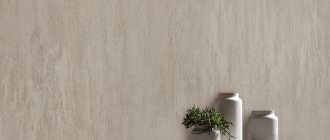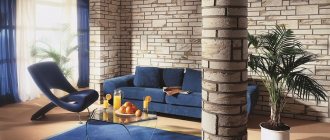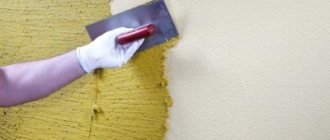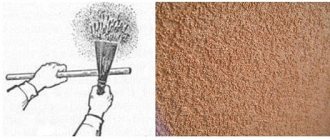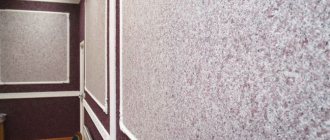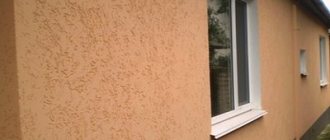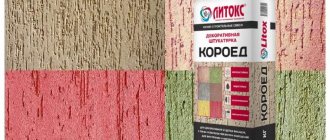Excellent protection against bad weather and climate conditions are the main advantages of “lamb” plaster. In addition to technical advantages, it combines quality with a relatively low price.
The plaster is called “lamb” because of the unusual pattern that results after the material dries on the wall. In a sense, it replaced the material made of sand and cement, called “fur coat” in our area. The material turned out to be better in every way than the old coating, which had many disadvantages.
Modern technologies have made it possible to create a comfortable texture with a distinctive pattern that does not rub off from the surface after drying. The drawing can be made whatever your heart desires: it depends on the experience of the master.
What does it consist of?
Lamb plaster consists of mineral elements that are completely harmless to the environment and humans. If a façade is lined with it, the composition contains components that protect the material from moisture. Without this, the coating could not be durable. This plaster is based on natural ingredients - marble, quartz, etc. Steam does not stagnate on the “lamb”, but, on the contrary, passes through it perfectly.
Everything is balanced in the structure. The composition contains granules up to 1.5 mm, so the finished mass fits well on the surface. Its consumption during application depends on the size of the fillers. The consumption for “lamb” is relatively small, since the thickness of the plaster layer depends on the size of the granules. The granules here are small compared to, for example, “bark beetle” plaster, which is similar in composition and appearance with a fraction of 1.5–3 mm.
Simple mixtures contain sand, which, after drying, settles on the outer layer. The “lamb” crumbs remain in the composition until dry. Usually the semi-finished product has a pale gray color, reminiscent of the skin of the animal of the same name, but the texture can additionally be colored with facade paints or interior paints (when used outside or for interior decoration).
Advice
The mixture can be made from cement, acrylic, silicone or silicate, and is often produced in the form of a ready-made dry mixture.
Composition of Lamb plaster
The main element that provides the unusual properties of the material is quartz or marble chips. It is with its help that a grainy surface is created. The diameter of the crumb varies from 1 to 4 millimeters. The size determines how embossed the surface pattern will be: the larger the size, the more grainy the surface will be. The composition may vary depending on the manufacturer. But the basic components remain the same.
The main feature of the components of the plaster is its environmental safety for health. Instead of marble and quartz, dolomite can also be used. The granules make the surface more durable and it does not settle even after a long period. Depending on the composition and properties, structural facing plaster Lamb comes in several types:
- cement-polymer;
- acrylic;
- silicone and silicate.
The classification is based on the binder component. The first type is produced in the form of dry mixtures. A distinctive feature of this option is its low cost. The remaining types are sold in the form of ready-made formulations that only need to be applied.
Photo
Below you can see photos of decorative plaster:
Application
This type of decorative plaster is more in demand for finishing the exterior walls of a building. Its pebble structure often decorates the facades of multi-story and private houses, office buildings, schools, and hospitals. Plaster mixtures are suitable for “wet facades” using mineral wool and expanded polystyrene.
For interior decoration, “lamb” is also used on landings, in halls, and in places with high traffic. Of course, it is suitable for any walls inside a living space if you decide to add such a texture to your interior.
The basis for plaster can be surfaces from:
Next, we’ll look at what mixtures you can choose for plastering and their features.
Preparatory work
The first thing to do is clean the surface to be plastered.
- Paint, old plaster, grease stains - all this needs to be removed, otherwise the material applied on top will begin to peel off.
- Any cracks or defects must be filled with putty.
- If fungus is detected, the surface must be cleaned mechanically, then covered with antiseptic agents. Then treat the wall with a primer - deep-penetrating or adhesive, depending on the type of surface to be applied. It is advisable that the primer and plaster be produced by the same manufacturer.
The coating should be applied to the following walls:
- brick;
- plasterboard;
- cement.
Attention
Before use, it is better to consult with a master finisher.
Watch a detailed video about preparing walls for applying decorative plaster.
Scope of application "Lamb"
Lamb plaster
You should not perceive the plastered surface only as a dirty gray area with traces of rubbing. Modern types of finishing materials, for example textured ones, which include “lamb” plaster, provide a completely different type of treated surfaces. Applied even to an uneven surface, decorative “lamb” plaster can radically change its appearance, turning previously unsightly irregularities into an element of the play of chiaroscuro on the wall or an interesting flow of an endless pattern. A well-prepared, smooth wall, covered with a layer of such plaster, only benefits from it, combining noble straightness with the volumetric texture of the top layer, devoid of monotony. This composition can be used to cover both the external surfaces of a building exposed to atmospheric and natural influences, as well as internal premises that require a high level of environmental safety.
Content:
- Scope of application "Lamb"
- Composition of “Lamb” plaster
- Plaster application technology
Necessary tool
Coating with decorative plaster can be carried out within a temperature range of 5 to 30 degrees Celsius.
You need to prepare the necessary tools for this:
- painting tape or other dense materials to protect from paint those areas that do not need to be painted;
- spatulas - several pieces of different sizes;
- container in which the solution will be mixed;
- sponge or rag to wipe tools;
- paint to cover your type of surface.
You also need gloves to protect your skin.
Painting the surface of decorative plaster
If you decide to continue with the design, we recommend reading about the process of painting walls. The plastered surface must be painted with a roller or a wide brush.
To soften the colors, use a mitten, and a deeper relief is created with an ordinary foam sponge.
For a richer appearance, silver or golden glaze can be applied to the protruding surfaces of the coating. The main thing in this matter is not to overdo it.
Advice! Walls can always be repainted without changing the texture. This is the advantage of plaster.
For additional shine and strength, you can apply special wax to the surface. This will extend the life of the coating!
Algorithm for applying to the wall
You need to spread the mortar onto the wall with a trowel, then you can level it with a spatula and rub it in with a trowel. The mixture is best applied gradually, one square meter at a time. The surface must be leveled within 15 minutes so that it does not dry out by this time, level it with a grater. The layer should be equal to the thickness of the granules - up to 1.5 cm. But the plastered surface should not be too thin: the base should be completely covered with the mixture.
Small granules in the composition will disperse accidentally . After application, the surface will be covered with a pattern depending on the size of the crumb.
When working with the solution, it must be stirred in a container, adding a little water to prevent premature thickening.
To prevent the edges of the plaster from drying out prematurely while working on one area of the wall, it is worth working in pairs. The first one applies the solution, the second levels it or works on the texture.
Important
If the edges dry out prematurely, when all the work is done, the parts will begin to stand out.
Having diluted the mixture, it is best to apply the mixture exactly to the next wall or window opening. Complete drying time is a minimum of 8 hours and a maximum of 2 days. The period depends on the mixture itself and the area of the base to be applied.
You need to paint the “lamb” with a wide brush and roller. A mitten will help soften the colors, and a simple foam sponge can create relief. An aesthetically rich look can be recreated using gold or silver glaze, but don’t go overboard.
The advantage of coloring is that it does not change the texture, and the colors can always be changed. For greater protection, the surface can be coated with wax or varnish.
Check out the instructions for applying lambskin plaster below.
Application technology
There are two ways to apply the material: with a trowel and spraying with a cartouche gun. Let's take a closer look at how the “lamb” texture is made using each of the plastering methods.
Trowel
- I apply the finished or mixed plaster with a spatula from the container onto a metal trowel.
- Holding the tool at an angle to the wall of approximately 45°, apply the mixture in an even layer. Its thickness must be brought to the grain size, i.e. 1.5-2.5 mm. Level the applied layer until no more plaster remains on the trowel.
- It is better to work in squares with an area of 1 - 1.5 m2, because the material sets in 15 - 20 minutes. During this time, it is necessary to level the “lamb” and grout.
- After application, the entire plastered surface must be rubbed with a plastic trowel - a smoothing iron - to highlight the pebble texture. The tool is pressed against the wall with its entire plane and, with slight pressure, is processed in a circular motion.
- Then they move on to decorating the next section of the wall, repeating the entire technology.
Machine application
To apply the “lamb” mechanically, use a cartouche gun connected to a compressor. This is how staircases in the entrance and large facades of buildings are mainly finished.
- The prepared solution is placed in the gun tank.
- Turn on the compressor and spray it evenly onto the wall surface.
- There is no need to rub over the decorative paint with this method of application, because... For machine application, plaster with a fine fraction of crumbs is used, and grouting will smooth out the sprayed texture and become less expressive.
Plaster consumption per 1 m2
Plaster under the “lamb” is placed in one layer with a thickness equal to the grain size. Therefore, the consumption of the decorative mixture will directly depend on this parameter.
- With a granule size of 1.5 mm, the consumption will be 2.5 kg/m2.
- With a value of 2 mm, the consumption will be 3 kg/m2.
Drying time is related to air temperature and the ability of the substrate to absorb moisture. The decor finally hardens after 12 – 24 hours. After a day, the finish becomes resistant to precipitation.
Manufacturers
In order not to make a mistake when choosing, you need to find out about the manufacturers and their products:
- Ceresit is a facade plaster produced by the German concern Henkel. It is well known in Russia and occupies a leading position in the finishing materials market. The brand has a wide range of materials for decorative plastering.
- Bolars is a material originally from Russia, based on German equipment. In 1999, production of this brand was launched. The products have repeatedly received quality marks. Today it is a recognizable and sought-after brand.
- Knauf is one of the most famous brands in the construction market. Has many options in choosing the basis for the facade. The company began its development back in 1932, because this manufacturer has extensive experience and knowledge, thanks to which at the current time the quality of their products is not in doubt.
- Bolix is a Polish-made decorative plaster that is also famous in Russia. The assortment includes a large selection of different colors and volumes.
Caparol, made in Germany, is known in Europe. A high-quality mixture with excellent protection properties.
- TIM 26 has good frost resistance, facade plaster has many other advantages: protection from water, elasticity, durability. The mixture can be used to cover buildings in frosty areas of Europe. Produced in Russia.
- Prospectors - produced by a popular company in the Russian Federation of the same name, which has been selling products since 1992. Goods of good quality and affordable price.
- Volma is a very durable cement mixture. Produced at the Volgograd gypsum plant. Volma is the leader in Russia in terms of production volumes.
- Kreisel is distinguished by good quality, relatively affordable price, as well as a pleasant, easy application of plaster. A mixture of German production.
- Bergauf is a versatility and a wide range of properties such as protection from cold, plasticity, protection from water, and thermal insulation. A large range of products allows you to choose a mixture for almost any situation. Produced in the Sverdlovsk region.
- Perfekta – designed for covering facades, plinths and industrial premises. It is resistant to weather conditions and physical damage.
- OSNOVIT is a product of a modern Russian manufacturer. The company is one of the leaders in the construction market. The base of this material allows steam to pass through itself and is resistant to damage and weather conditions.
Advice
If you want to buy Lamb plaster, we advise you to first decide on the design, and then make your choice in favor of a specific material.
Which composition to choose?
Decorative plaster represents a class of environmentally friendly materials. The binding basis in its composition is one of the components: cement, acrylic, silicone. The second component is stone granules, for example, marble chips, which form the “lamb” texture.
The grain size of marble chips in the plaster determines the expressiveness of the texture, the thickness of the applied layer, the mixture consumption, and the method of application.
- 1 mm - suitable for machine application over large areas;
- 1.5 mm, 2 mm, 2.5 mm - the most popular grain sizes, mainly used on facades for manual plastering;
- 3 mm, 4 mm - mixtures with this fraction size exist, but are rarely used.
Acrylic plaster
The main ingredient is acrylic resin, which gives the strength of the layer of the finished material. It is not afraid of moisture, sunlight, dirt, low or high temperatures.
Sold ready for application, in buckets of 25 - 30 kg.
Popular brands: Bayramix “Palta”, Prorab “Optima”, etc.
If the plaster is not painted, then before application you need to add color to it yourself or order it from a specialist. Antifungal and antiseptics can be used as additives.
The composition of acrylic plaster is very plastic. It can be used to cover various protruding decorative elements of a building.
A distinctive feature is the speed of hardening. It is necessary to work without long breaks so that visible seams do not form. Constantly stir the remainder in the bucket until smooth.
The finish is durable and easy to maintain. This is a good option for decorative “lamb-look” plastering inside the house and for exterior work when installing a “wet facade” using polystyrene foam insulation.
Silicone mixture
The main component, silicone resin, provides the best performance. This plaster is used for facade finishing over mineral (basalt) wool.
The material is more expensive than acrylic plaster, but has better performance.
The advantages of this type:
- durability, resistance to abrasion, frequent rains, service life up to 20 years;
- vapor permeability, tolerates moisture and high temperatures, does not form mold or mildew;
- The flexibility of the material prevents the coating from changing when damaged.
Mineral mixture
This is the cheapest type of mixture for “lamb”. Cement serves as the basis for bonding mineral chips. Grain size ranges from 1.5 -2.5 mm. The plaster is sold dry in 25 kg bags, diluted with water before use.
Reviews
- Oleg. We were advised to do lamb plaster purely for technical reasons. The fact is that the wall in the house often cracks, and on a flat surface this is very noticeable. After the relief plaster was applied, the problems decreased:
- Firstly, small cracks and scratches are completely invisible.
Secondly, after a while you can just touch it up a little and nothing will be noticeable at all.
- Igor .
I am pleased with the lamb plaster that it is very resistant to all kinds of damage. We have two children in our house and a ball or something else is constantly flying into the wall. No special scuffs or scratches should be noticeable. An excellent option for those who want to save a lot of money and at the same time get a beautiful and smooth facade. Plus a wide selection of colors. If you need soft yellow or bright orange, you can choose the appropriate option to suit your requirements and wishes. - Marina . I ordered Lamb plaster considering its affordable price and technical performance. Ideally helped to hide all the unevenness on our walls. I thought that it would be much more dirty than usual, but in the end it turned out to be the opposite. The material looks quite beautiful and is very economical. A good option for every family. I recommend.
Plus, of course, I consider the low price and relative ease of application to be an advantage. Even if the master is not a top-level professional, it will still turn out very well. But if you apply even putty, then a jack of all trades really needs to get down to business.
How to prepare plaster mortar with your own hands
Mix the prepared dry mixture in equal parts. The percentage is indicated on the product packaging. The finished composition should be similar in consistency to a paste.
Stir the resulting mixture using a special attachment with an electric drill or mixer. Leave for a few minutes, then stir the mixture again.
Apply the finished mixture to the surface using a stainless steel trowel, and then level it.
In this process, mineral granules are distributed randomly. And on the surface of the wall there remains a trace equal to the size of a granule.
Plastering
Composition of the mixture for the production of textured plastering
- The finished mixture is produced on the basis of M400 cement. In modern compositions, cement is replaced with acrylic resin or a silicone base.
- Crushed granite chips are added to the base. The size fractions range from 1 mm to 4 mm. The percentage of crumbs in the composition is increased to 85 units. This allows you to obtain an even textured layer with the required pattern.
Fact! Textured plaster Bark beetle is, in principle, identical in composition to Lamb, but the percentage of crumbs in the mixture is 40 units. This is necessary to produce furrows along the main binder layer. This surface looks like wood eaten by a bark beetle.
- Coloring pigments are added when making the mixture. Initially, the composition has a gray or whitish color, which corresponds to the base. Alternatively, painting can be done after the material has been applied and dried to the walls.
Surfaces suitable for applying Lamb plaster
Textured plaster does not have any special opposition from the main materials of load-bearing walls. A layer of this mixture is applied only to the base layer of ordinary plaster. As a conclusion, we can conclude that Lamb plaster is applied to a flat surface with a cement base.
The only important condition is the need to use a plaster mesh when applying the base base. Cracks on the surface of decorative plaster are not only clearly visible, but can accumulate unwanted moisture. Under the influence of frost it leads to the destruction of the material.
Surfaces to be plastered:
- Reinforced concrete wall slabs.
- Ceramic masonry bricks or ceramic blocks.
- Wall blocks made of foam concrete or aerated concrete
- Wall surfaces are pre-finished with insulation made of mineral wool slabs or expanded polystyrene slabs.
Preparing the surface for applying decorative plaster;
All surfaces must be pre-treated to remove dust using a deep penetration primer.- Applying the initial layer of base plaster. If a large layer is required, a metal plaster mesh is used to maintain the composition. This action is necessary when plastering brick walls. The geometry of the masonry material does not have clear boundaries and deviations from the vertical are possible.
- Using a spatula, apply a fiberglass mesh with a mesh size of 4 x 4 mm onto the wet plaster. It is the basis of the base layer frame.
- The surface is finally leveled with an additional layer of base plaster. Allow the necessary time for the base to dry before applying the finishing coat.
- The end of the finishing work on the facade of the building is the process of applying Lamb textured plaster painted in the required color.
How to prepare the Lamb mixture with your own hands:
- The dry mixture is poured into a container.
- Water is added gradually.
- The composition is stirred with an electric mixer to obtain an even, homogeneous mixture. The consistency of the material should resemble thick sour cream.
- If you decide to use color, you need to add polish while mixing the main ingredients.
Important! To obtain a uniform color in batches of different times, it is necessary to divide the dye into equal parts and add an equal part of the pigment to the same amount of the mixture. The new composition is mixed in a clean container. This must be taken into account to avoid adding tone from the previous batch.
How to properly apply the finished mixture to the surface
To work, you need to prepare a rectangular steel trowel, a plasterer's trowel, a wide paint brush, a roller for applying a textured pattern, a polyurethane float for leveling the surface, and scaffolding for performing work at height.
The process itself consists of simple steps:
- The finished surface plastered with a base layer is treated with a primer to remove dust.
- The solution is applied with a trowel to the lower third of the wide part of the trowel.
- The tool with the material is positioned relative to the wall surface at an angle of 450. Lightly pressing the trowel, it is necessary to apply the plaster to the wall in a layer equal in thickness to the size of the grains in the material. Work is carried out from bottom to top. It is more convenient to immediately apply the solution to an area of no more than 2 m2. This method will allow you to work with the material to level and grout the surface until it sets within 10 minutes. To obtain a simple, flat surface with a classic lamb skin pattern, rub the surface with a polyurethane grater in a circular motion with light pressure.
- Then the next square is covered.
Interesting! To give a special surface pattern, you can use a textured roller. The depth of the pattern is chosen relative to the thickness of the layer. The surface can also be refined with a simple shoe brush. A unique pattern is applied using circular movements. In case of an error, corrections are made with a wet paint brush.

